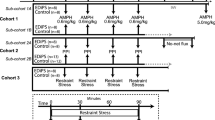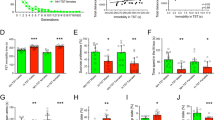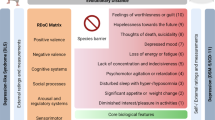Abstract
The Wistar–Kyoto (WKY) rat strain demonstrates endogenous hormonal and behavioral abnormalities that emulate many of those found in symptom-presenting depressive patients. Evidence suggests that the WKY strain may harbor heterogeneity not found in other inbred strains, including greater behavioral and genetic variability. We took advantage of this variability and selectively bred WKY for ‘depressive’ behavior using immobility in the forced swim test (FST) as a functional selector. Successive generations of selective breeding resulted in rats that exhibited the extremes of immobility in the FST: ‘WKY most immobile’ (WMI) and ‘WKY least immobile’ (WLI). Male WMI rats also showed significantly decreased activity in the open field test (OFT). Plasma corticosterone (CORT) response to restraint stress was significantly lower and less variable in WMI compared to WLI males. Subacute treatment of males with several classes of antidepressant had different effects on FST behavior in the two substrains. Both desipramine (10 mg/kg body weight), a tricyclic antidepressant, and phenelzine (7.5 mg/kg), a monoamine oxidase inhibitor, significantly and drastically decreased FST immobility in WMI. In contrast, WLI showed a limited response to these antidepressants. Neither substrain responded to fluoxetine (10 mg/kg), a selective serotonin reuptake inhibitor. These data show that selective breeding of WKY rats has resulted in two substrains with reduced variability and differing responsiveness to antidepressants, which represent a novel means to dissect the molecular mechanisms underlying depressive behavior.
This is a preview of subscription content, access via your institution
Access options
Subscribe to this journal
Receive 12 print issues and online access
$259.00 per year
only $21.58 per issue
Buy this article
- Purchase on Springer Link
- Instant access to full article PDF
Prices may be subject to local taxes which are calculated during checkout




Similar content being viewed by others
References
Okamoto K, Aoki K . Development of a strain of spontaneously hypertensive rats. Jpn Circ J 1963; 27: 282–293.
Solberg LC, Olson SL, Turek FW, Redei E . Altered hormone levels and circadian rhythm of activity in the WKY rat, a putative animal model of depression. Am J Physiol Regul Integr Comp Physiol 2001; 281: R786–R794.
Redei E, Pare WP, Aird F, Kluczynski J . Strain differences in hypothalamic-pituitary-adrenal activity and stress ulcer. Amer J Physiol 1994; 266: R353–R360.
Gomez F, Lahmame A, de Kloet ER, Armario A . Hypothalamic–pituitary–adrenal response to chronic stress in five inbred rat strains: differential responses are mainly located at the adrenocortical level. Neuroendocrinology 1996; 63: 327–337.
Porsolt RD, Le Pichon M, Jalfre M . Depression: a new animal model sensitive to antidepressant treatments. Nature 1977; 266: 730–732.
Porsolt RD, Anton G, Blavet N, Jalfre M . Behavioural despair in rats: a new model sensitive to antidepressant treatment. Eur J Pharmacol 1978; 47: 379–391.
Porsolt RD, Bertin A, Jalfre M . ‘Behavioural despair’ in rats and mice: strain differences and the effects of imipramine. Eur J Pharmacol 1978; 51: 291–294.
Rittenhouse P, Lopez-Rubalcava C, Stanwood G, Lucki I . Amplified behavioral and endocrine responses to forced swim stress in the Wistar–Kyoto rat. Psychoneuroendocrinology 2002; 27: 303–318.
Pare WP . Open field, learned helplessness, conditioned defensive burying, and forced-swim tests in WKY rats. Physiol Behav 1994; 55: 433–439.
Pare WP . Learning behavior, escape behavior, and depression in an ulcer susceptible rat strain. Integr Physiol Behav Sci 1992; 27: 130–141.
Lahmame A, Armario A . Differential responsiveness of inbred strains of rats to antidepressants in the forced swimming test: are Wistar–Kyoto rats an animal model of subsensitivity to antidepressants? Psychopharmacology 1996; 123: 191–198.
Armario A, Gavalda A, Marti J . Comparison of the behavioural and endocrine response to forced swimming stress in five inbred strains of rats. Psychoneuroendocrinology 1995; 20: 879–890.
Berton O, Ramos A, Chaouloff F, Mormede P . Behavioral reactivity to social and nonsocial stimulations: a multivariate analysis of six inbred rat strains. Behav Genet 1997; 27: 155–166.
Lahmame A, del Arco C, Pazos A, Yritia M, Armario A . Are Wistar–Kyoto rats a genetic animal model of depression resistant to antidepressants? Eur J Pharmacol 1997; 337: 115–123.
Lopez-Rubalcava C, Lucki I . Strain differences in the behavioral effects of antidepressant drugs in the rat forced swimming test. Neuropsychopharmacology 2000; 22: 191–199.
Paul IA, Duncan GE, Kuhn C, Mueller RA, Hong JS, Breese GR . Neural adaptation in imipramine-treated rats processed in forced swim test: assessment of time course, handling, rat strain and amine uptake. J Pharmacol Exp Ther 1990; 252: 997–1005.
Millan MJ, Newman-Tancredi A, Rivet JM, Brocco M, Lacroix P, Audinot V et al. S 15535, a novel benzodioxopiperazine ligand of serotonin (5-HT)1A receptors: I. Interaction with cloned human (h)5-HT1A dopamine hD2/hD3 and h alpha2A-adrenergic receptors in relation to modulation of cortical monoamine release and activity in models of potential antidepressant activity. J Pharmacol Exp Ther 1997; 282: 132–147.
Skrebuhhova T, Allikmets L, Matto V . Effects of anxiogenic drugs in rat forced swimming test. Methods Findings Exp Clin Pharmacol 1999; 21: 173–178.
Kurtz TW, Morris RCJ . Biological variability in Wistar–Kyoto rats: implications for research with the spontaneously hypertensive rat. Hypertension 1987; 10: 127–131.
Pare WP, Kluczynski J . Differences in the stress response of Wistar–Kyoto (WKY) rats from different vendors. Physiol Behav 1997; 62: 643–648.
Kurtz TW, Montano M, Chan L, Kabra P . Molecular evidence of genetic heterogeneity in Wistar–Kyoto rats: implications for research with the spontaneously hypertensive rat. Hypertension 1989; 13: 188–192.
Matsumoto K, Yamada T, Natori T, Ikeda K, Yamada J, Yamori Y . Genetic variability in SHR (SHRSR), SHRSP and WKY strains. Clin Exp Hyp 1991; 13: 925–938.
Deschepper CF, Prescott G, Hendley ED, Reudelhuber TL . Genetic characterization of novel strains of rats derived from crosses between Wistar–Kyoto and spontaneously hypertensive rats, and comparisons with their parental strains. Lab Anim Sci 1997; 47: 638–646.
Detke MJ, Rickels M, Lucki I . Active behaviors in the rat forced swimming test differentially produced by serotonergic and noradrenergic antidepressants. Psychopharmacology 1995; 121: 66–72.
Solberg L, Ahmadiyeh N, Baum A, Vitaterna M, Takahashi J, Turek F et al. Depressive-like behavior and stress reactivity are independent traits in a Wistar–Kyoto × Fisher 344 cross. Mol Psychiatry (in press).
Bailey D . Sources of subline divergence and their relative importance for sublines of six major inbred strains of mice. In: Ed H (ed). Origins of Inbred Mice. Academic Press: New York, 1978, pp 197–215.
Bailey D . How pure are inbred strains of mice? Immunol Today 1982; 3: 210–214.
Drake JW, Charlesworth B, Charlesworth D, Crow JF, Kodama S . Rates of spontaneous mutation: failure to complement abnormal phenotypes of simian virus 40-transformed Werner syndrome cells by introduction of a normal human chromosome 8. Genetics 1998; 148: 1667–1686.
Liebsch G, Montkowski A, Holsboer F, Landgraf R . Behavioural profiles of two Wistar rat lines selectively bred for high or low anxiety-related behaviour. Behav Brain Res 1998; 94: 301–310.
Pare WP . The performance of WKY rats on three tests of emotional behavior. Physiol Behav 1992; 51: 1051–1056.
Fernandez-Guasti A, Martinez-Mota L, Estrada-Camarena E, Contreras CM, Lopez-Rubalcava C . Chronic treatment with desipramine induces an estrous cycle-dependent anxiolytic-like action in the burying behavior, but not in the elevated plus-maze test. Pharmacol Biochem Behav 1999; 63: 13–20.
Marti J, Armario A . Forced swimming behavior is not related to the corticosterone levels achieved in the test: a study with four inbred rat strains. Physiol Behav 1996; 59: 369–373.
Gold PW, Chrousos GP . Organization of the stress system and its dysregulation in melancholic and atypical depression: high vs low CRH/NE states. Mol Psychiatry 2002; 7: 254–275.
Lachman HM, Papolos DF, Weiner ED, Ramazankhana R, Hartnick C, Edwards E et al. Hippocampal neuropeptide Y mRNA is reduced in a strain of learned helpless resistant rats. Brain Res Mol Brain Res 1992; 14: 94–100.
Lachman HM, Papolos DF, Boyle A, Sheftel G, Juthani M, Edwards E et al. Alterations in glucocorticoid inducible RNAs in the limbic system of learned helpless rats. Brain Res 1993; 609: 110–116.
Henn F, Edwards E, Muneyyirci J . Animal models of depression. Clin Neurosci 1993; 1: 152–156.
King JA, Campbell D, Edwards E . Differential development of the stress response in congenital learned helplessness. Int J Dev Neurosci 1993; 11: 435–442.
King JA, Edwards E . Early stress and genetic influences on hypothalamic–pituitary–adrenal axis functioning in adulthood. Hormones Behav 1999; 36: 79–85.
King JA, Abend S, Edwards E . Genetic predisposition and the development of posttraumatic stress disorder in an animal model. Biol Psychiatry 2001; 50: 231–237.
Weiss JM, Cierpial MA, West CHK . Selective breeding of rats for high and low motor activity in a swim test: toward a new animal model of depression. Pharmacol Biochem Behav 1998; 61: 49–66.
West CH, Weiss JM . Effects of antidepressant drugs on rats bred for low activity in the swim test. Pharmacol Biochem Behav 1998; 61: 67–79.
West CH, Bonsall RW, Emery MS, Weiss JM . Rats selectively bred for high and low swim-test activity show differential responses to dopaminergic drugs. Psychopharmacology 1999; 146: 241–251.
West CH, Boss-Williams KA, Weiss JM . Motor activation by amphetamine infusion into nucleus accumbens core and shell subregions of rats differentially sensitive to dopaminergic drugs. Behav Brain Res 1999; 98: 155–165.
Acknowledgements
This work was supported by NIH Grant MH60789 to EER. We thank Leah C Solberg, Amber E Baum, and Genn M Suyeoka for their invaluable help.
Author information
Authors and Affiliations
Corresponding author
Rights and permissions
About this article
Cite this article
Will, C., Aird, F. & Redei, E. Selectively bred Wistar–Kyoto rats: an animal model of depression and hyper-responsiveness to antidepressants. Mol Psychiatry 8, 925–932 (2003). https://doi.org/10.1038/sj.mp.4001345
Received:
Revised:
Accepted:
Published:
Issue Date:
DOI: https://doi.org/10.1038/sj.mp.4001345
Keywords
This article is cited by
-
Validation of Wistar-Kyoto rats kept in solitary housing as an animal model for depression using voxel-based morphometry
Scientific Reports (2024)
-
Contribution of changes in the orexin system and energy sensors in the brain in depressive disorder - a study in an animal model
Pharmacological Reports (2024)
-
Positive maternal affect during mother–litter interaction is reduced in new mother rats exhibiting a depression-like phenotype
Scientific Reports (2023)
-
Differential Effects of Neonatal Ventral Hippocampus Lesion on Behavior and Corticolimbic Plasticity in Wistar–Kyoto and Spontaneously Hypertensive Rats
Neurochemical Research (2023)
-
Maternal stress and vulnerability to depression: coping and maternal care strategies and its consequences on adolescent offspring
Translational Psychiatry (2022)



